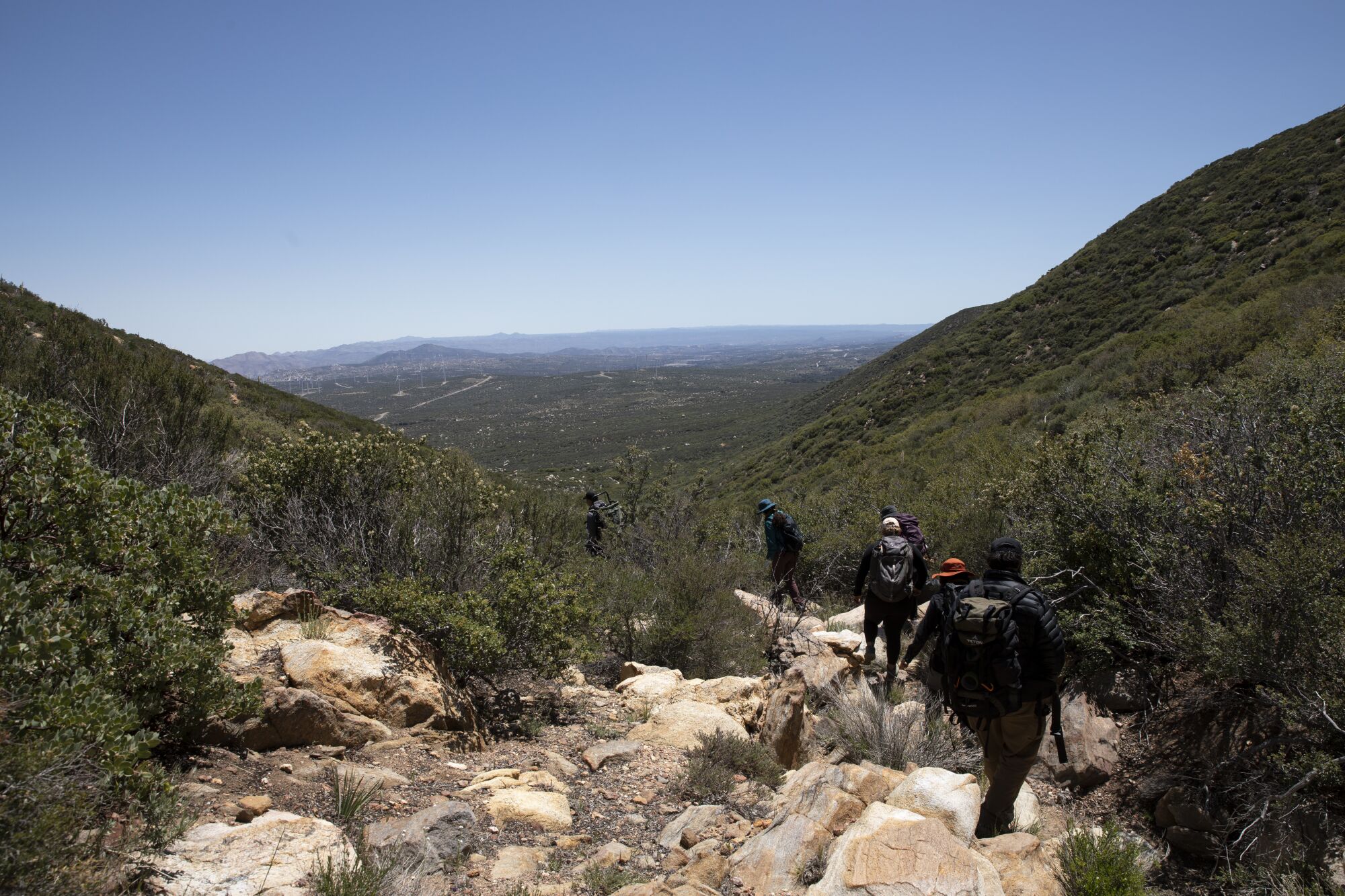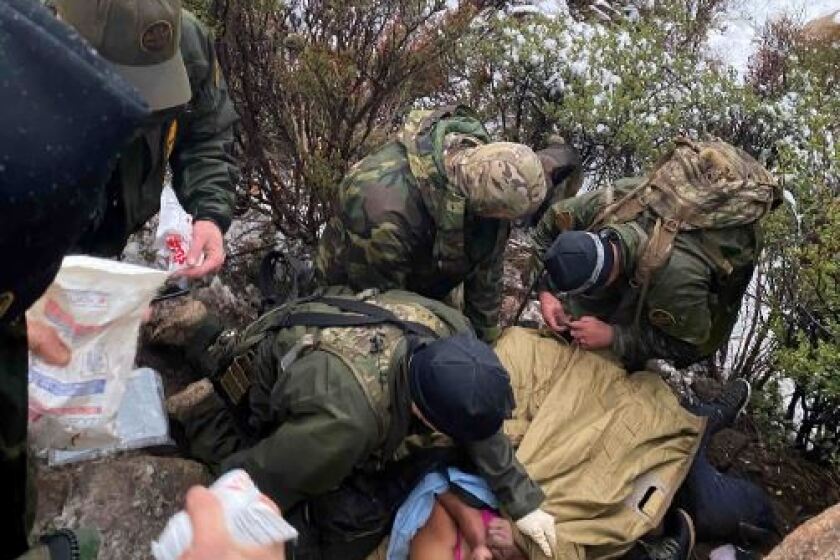
Click here to view the original news story
Border aid groups are focusing on leaving supplies at more remote locations, such as in the San Diego County mountains where three sisters died in 2020
Through dense vegetation, they charted a course toward a dry creek bed known as the Shrine Trail, named for the small religious altar built along the route. For those who typically use this path, it’s a point of no return, the last place before the trail descends that they can look back and see Mexico on the hazy horizon.
Scrambling over steep, rocky hills, through thick scrub brush and around cacti, the group finally reached their destination: a boulder marking the spot where three Mexican sisters died of hypothermia after crossing the U.S.-Mexico border in February 2020.
The group’s leader hammered the crosses into the ground, one for each of the dead. Then they turned their attention to the living, leaving two-gallon jugs of water, canned food and other supplies that they hope will prevent other migrants from meeting the same fate as the sisters from Oaxaca.
Though hundreds of migrants die each year along the U.S.-Mexico border, the deaths of sisters Juana, Margarita and Paula Santos Arce three years ago struck a particularly raw nerve for those performing humanitarian water and supply drops in San Diego County, sparking a yearslong outpouring of grief and remembrance.
Their deaths also influenced a change in the way the aid groups operate along the California-Mexico border, prompting them to leave their life-saving stockpiles of goods in more remote areas where migrants have died or been rescued — even if fewer migrants pass through those areas — rather than focusing primarily on more easily accessible and heavily trafficked routes.
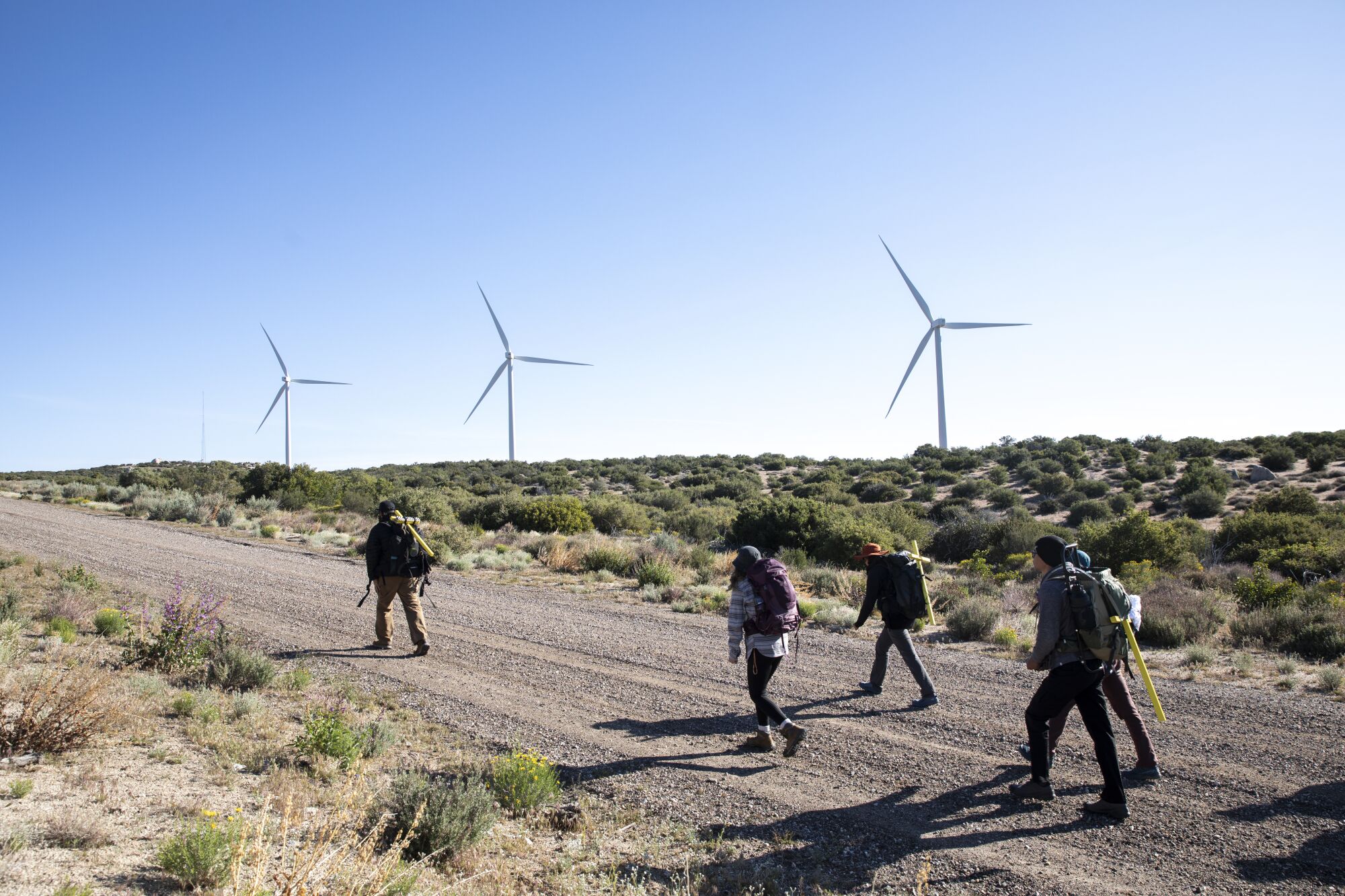
“Once we find out about an area where someone has passed away … (we) have a moral responsibility to do something about it,” said James Cordero, the water drop co-director at Border Kindness, an El Centro-based organization that provides food, shelter, legal services and other aid for migrants. “They were not the first ones to pass through there and won’t be the last.”
David Greenblatt is a surgeon with Sharp Rees-Stealy medical group who volunteers most Saturdays lugging supplies for migrants into the desert or mountains. “Any place somebody has died deserves our efforts,” said Greenblatt, who is not affiliated with any groups but previously volunteered with Border Angels and Border Kindness.
He said that since the sisters’ deaths, humanitarian volunteers have developed several new routes around the coordinates where migrants have either died or been rescued. Previously, the routes were largely developed based on signs of migrant traffic, such as discarded supplies and clothing.
“This inspired and motivated us and had a direct logistical effect on how we operate,” Greenblatt said.
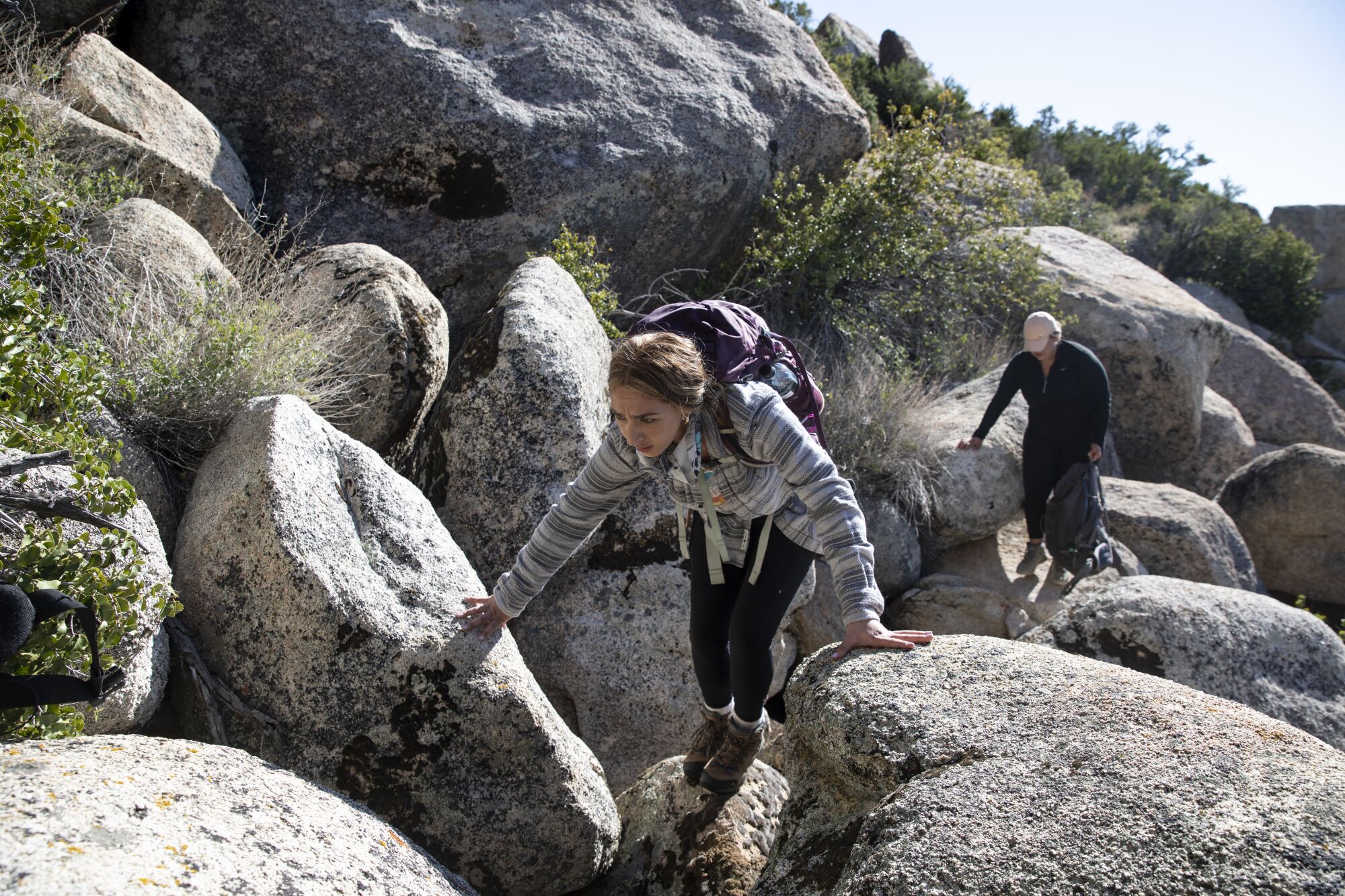
‘El sueño americano’
Lack of work in their small Oaxacan town sent the Santos Arce sisters north to the U.S. to achieve “el sueño americano” — the American dream, family members told media outlets in Mexico. It was a seasonal migration that Juana, 35, Margarita, 32, and Paula, 29, had made before, typically to pick strawberries in the northwestern U.S.
They left in early 2020, this time with a nephew and Paula’s 18-month-old daughter. They agreed to pay $8,500 per person to be led into the U.S.
Smugglers brought the toddler across separately and sent the nephew with a different group. The three sisters were sent with a pair of guides, brothers from Chihuahua: Cecilio and Ricardo Rios-Quiñones.
Both sets of siblings were from poor, rural towns and searching for better lives for their large families, court documents show.
And none of them were prepared for the trip, even the supposed guides. Ricardo, now 25, had walked the route just one time with another group in order to learn how to navigate. Cecilio, 40, had reportedly never smuggled anyone.
The group set off Feb. 9, crossing the border near Campo. They knew it would be a multi-day journey but did not have proper clothing or supplies to prepare them for the elements. It was raining as they started, and on the second day, after already trekking at least 16 miles into higher elevation, they became caught in a snowstorm.
The Rios-Quiñones brothers huddled with the women near a large boulder with a small overhang, trying to keep them warm. In the early afternoon of Feb. 10, the brothers hiked to a spot where they could get cellphone reception and called 911.
By that time, one of the sisters was dead, and a second sister died during the three hours it took Border Patrol agents to reach the group. As day turned to night and temperatures on the snowy hillside plummeted, agents from the Border Patrol’s search-and-rescue team unsuccessfully tried to save Juana.
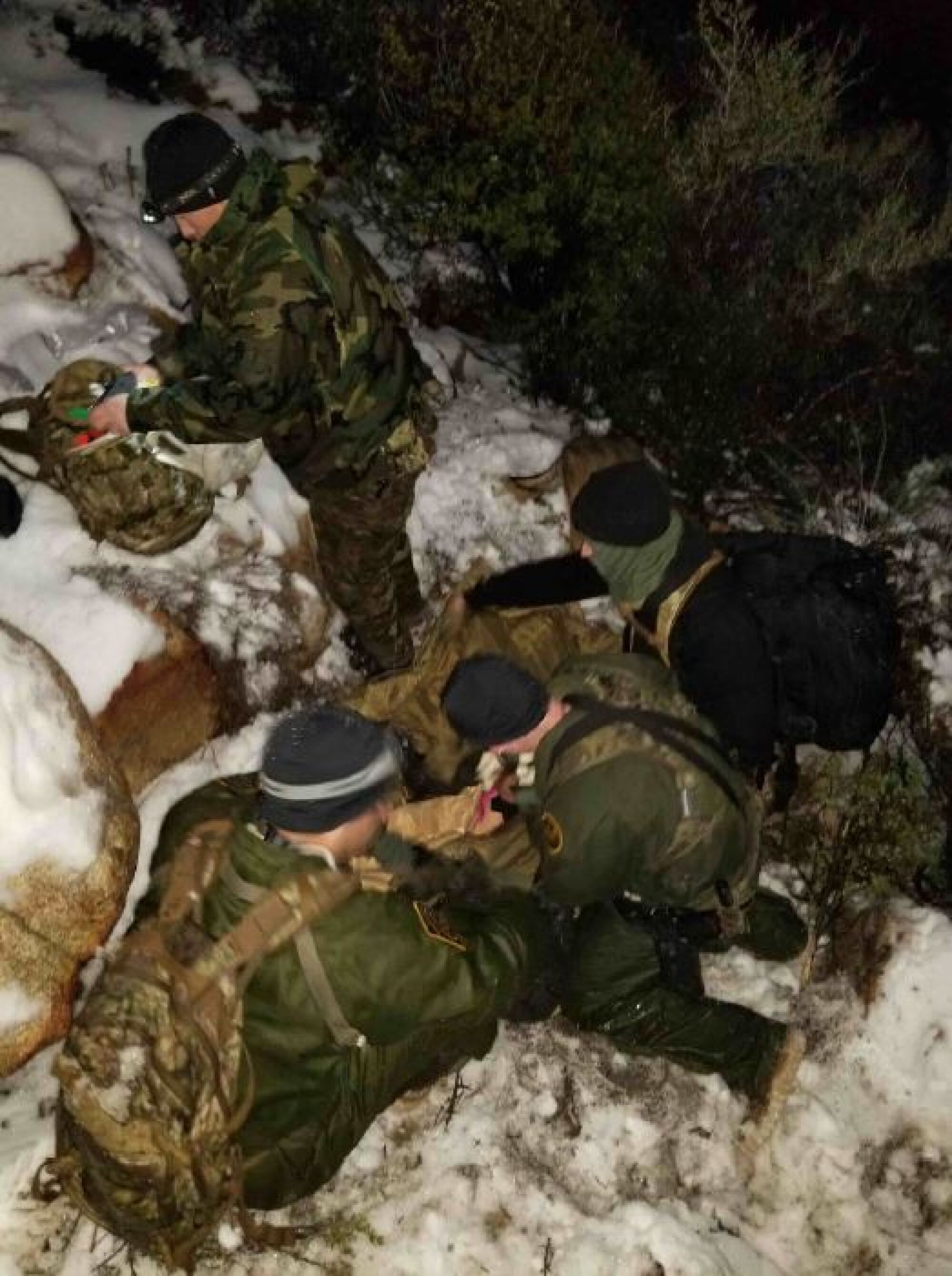
“The conditions were so horrible that we requested air support, but all air support was declined,” one of the agents said in an interview released by the Border Patrol’s San Diego sector chief.
“Half of our team, if not all of the team, was exhibiting signs of hypothermia,” another agent said in the video. One agent put his jacket around Juana, and another put his beanie cap on her head. “Unfortunately, after around 30 minutes, she succumbed to her illness and passed away. The look in her eyes, I see it when I look at my wife and my daughter. It’s hard.”
Before the team left, the lead agent collected their identification cards. It wasn’t until he got back to the station that he studied them closely and realized all three were sisters. “Somebody lost pretty much their whole family right there,” he said. The Border Patrol did not make the agents available for an interview.
The Mexican consulate in San Diego provided $6,600 to help get the sisters’ remains back to Oaxaca.
They were among an estimated 371 migrants who died or went missing in 2020 along the U.S.-Mexico border — a figure that is lower than in the years before or the year after, according to data from the Missing Migrants Project, an initiative by the International Organization for Migration. Experts have attributed the dip largely to the initial shockwaves of the COVID-19 pandemic, which shut down borders and shook up the global economy in a way that altered migration to the U.S.
But the number of deaths have sharply increased since, with nearly 600 in 2021 and even more last year. Humanitarian water and supply drops along the border have taken on a new urgency in light of the spike, even though the practice has a long history in California from groups like Border Angels and Water Station. Federal authorities typically don’t hassle the volunteers, they said, though there have been tensions over the years.
The search for the Shrine Trail
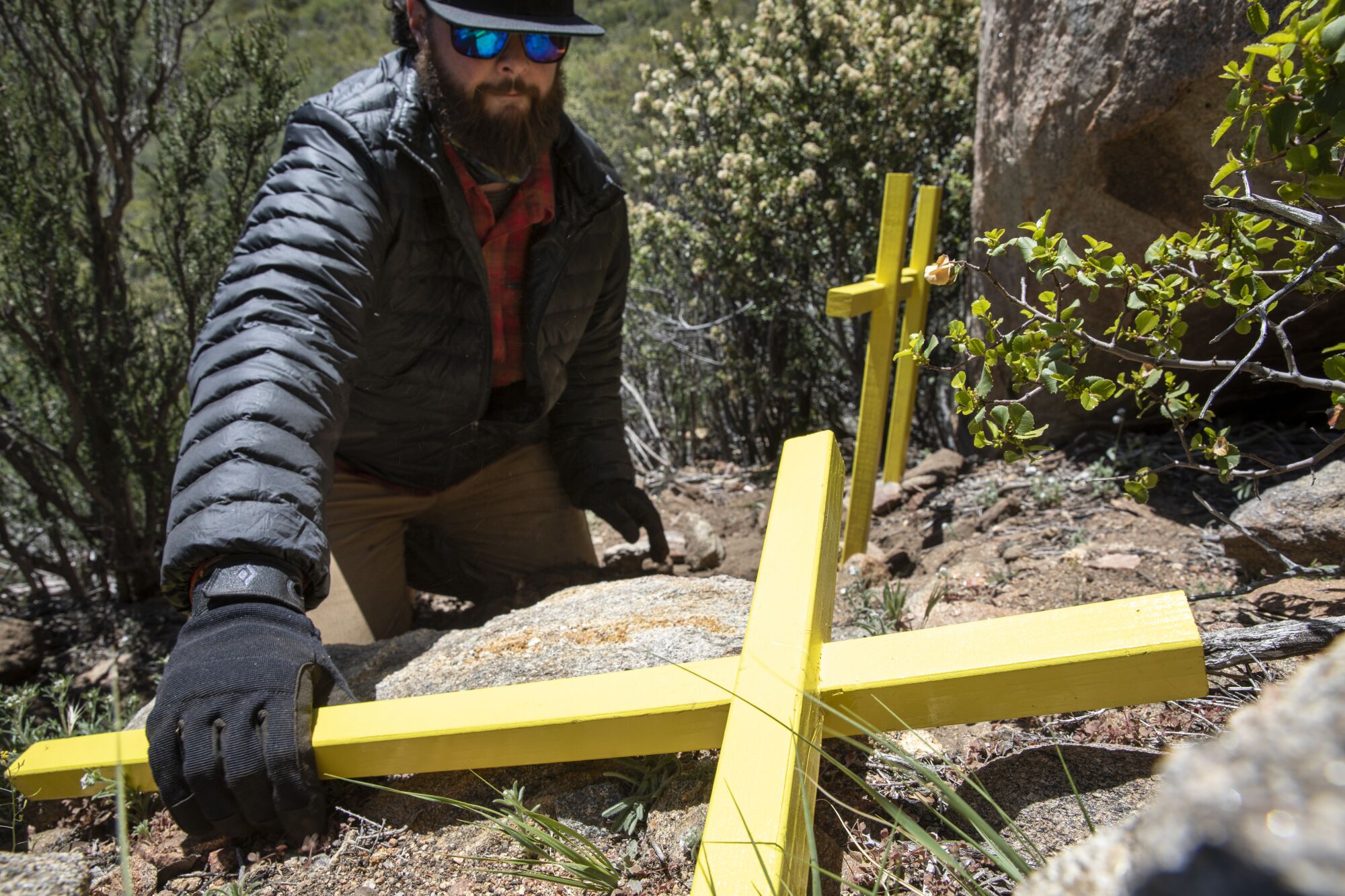
For more than a year, descriptions of the site provided by authorities were too vague for Cordero, the Border Kindness volunteer, to pinpoint its location.
That changed in April 2021 when the Rios-Quiñones brothers, who pleaded guilty to felony conspiracy and human smuggling charges, were sentenced to 5½ years each in federal prison. Prosecutors included in their sentencing documents more detailed descriptions of the site and Border Patrol photographs showing the terrain. That gave Cordero and Greenblatt, who were then volunteers with Border Angels, enough clues to begin their search for the route.
He set off by himself one day, fearing rattlesnake bites as he did some “intense bush-whacking.” But when he reached the canyon he’d identified as the likeliest place he’d find the trail, he began discovering discarded bottles, clothing items and other signs of migrant foot traffic. As he scrambled farther up the dry creek bed in the saddle between two hills, the views looking back toward the valley in the distance began matching up with a photo that Border Patrol agents had snapped from the rescue site.
“At first I felt great excitement when I realized I was on the right path,” Greenblatt recalled. But then, he started spotting evidence of the failed Border Patrol rescue efforts, including the green winter jacket the agent had used to try to keep Juana warm.
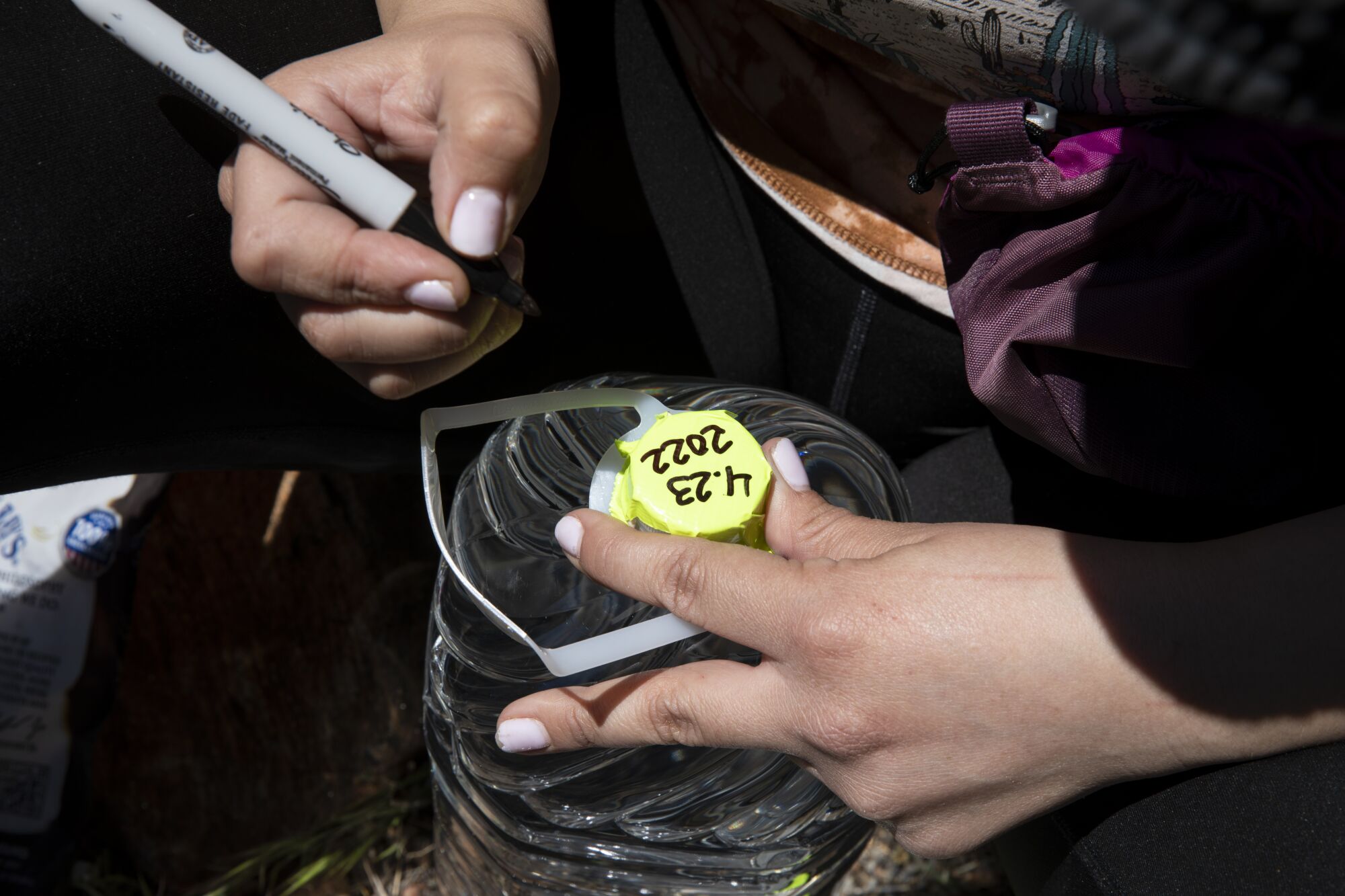
“I can’t think of another moment I’ve had like that,” Greenblatt said. “I was crying a lot … It was the first time I was at a site where something so terrible happened … where three sisters lost their lives together.”
Greenblatt felt a particular connection to the tragedy. On the day they died, he’d been recreating just miles away on Mount Laguna, spending a day off of work mountain biking and hiking in the snow.
“I was in Gore-Tex boots, jacket, pants, head-to-toe waterproof with no fear,” he said. “I had a grand old time, just a privileged person enjoying a rare storm in San Diego. It wasn’t until the next day I saw the news of this thing … That just really hit me, because of the proximity. I was so close and had no idea this tragedy was unfolding.”
A few weeks after his solo scouting trip to find the trail, on a warm Saturday in early May 2021, Greenblatt and Cordero led about 15 volunteers to the site, where the group found discarded medical supplies and jeans cut with trauma shears that offered more evidence of the rescue attempt. That party, which left a large cache of water and supplies, included a Franciscan priest hiking in his traditional brown hooded habit and corded rope belt.
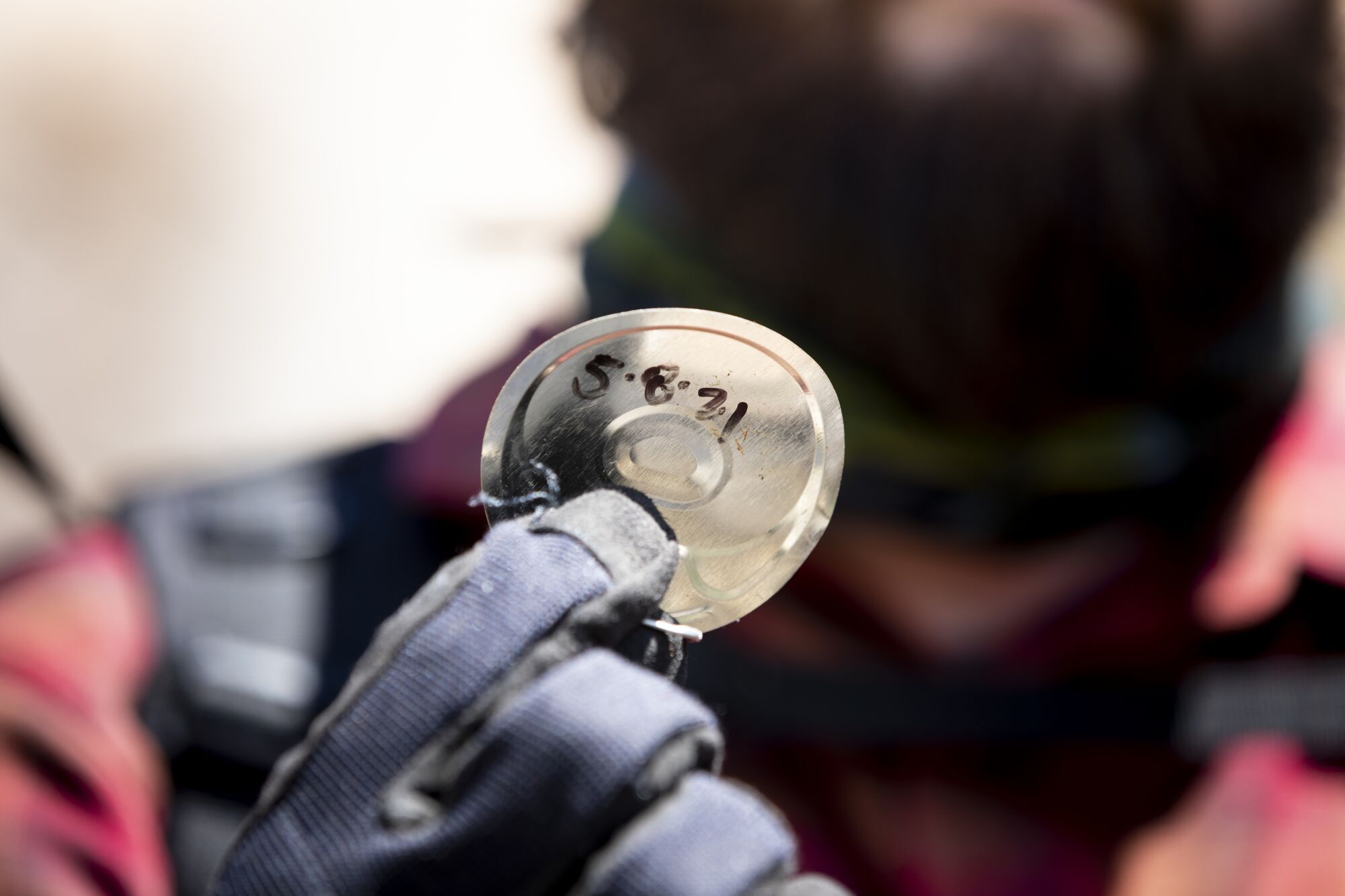
A priest’s blessing
For Sam Nasada, a native of Indonesia who moved to the U.S. in 1997, working with migrants goes hand-in-hand with the Franciscan order he chose when he decided to join the Catholic priesthood. St. Francis of Assisi, the 13th century Italian friar who founded the Franciscan order, embraced a life of poverty, which included ministering to outcast lepers and other poor and downtrodden members of society.
“That’s the spirit of the work we’re still trying to do,” said Nasada, a priest at Mission San Luis Rey Parish in Oceanside. “That’s how I see a connection with doing ministry at the border, for migrants and refugees.”
At the boulder where the sisters died, Nasada stood several moments in silence, his head bowed as he rested his hands on the massive rock.
“Creator God, we gather here to celebrate the lives of Juana, Paula, Margarita — your daughters, our sisters,” he began. “In this sacred land of the Kumeyaay, in this land that we now call the United States of America, they have lost their lives. We pray that you receive their souls to your side.”
Cordero, standing nearby, broke down in tears.
“I felt the pain and anger and everything that comes along with grief,” he later explained.
Nasada went on to ask God for “the courage, the spirit to continue our work, our effort to end the senseless death like this on our border. Lord, bless this land that no more death be on this land.”
Then speaking directly to the sisters, he told them, “Go with God. Go in peace. We remember you.”
About a year later, in late April 2022, a smaller group of six carrying the yellow crosses made the same trek. Cordero, the only volunteer to make both trips, spent several minutes carefully planting the crosses in the earth, fortifying them with small rocks around each base.
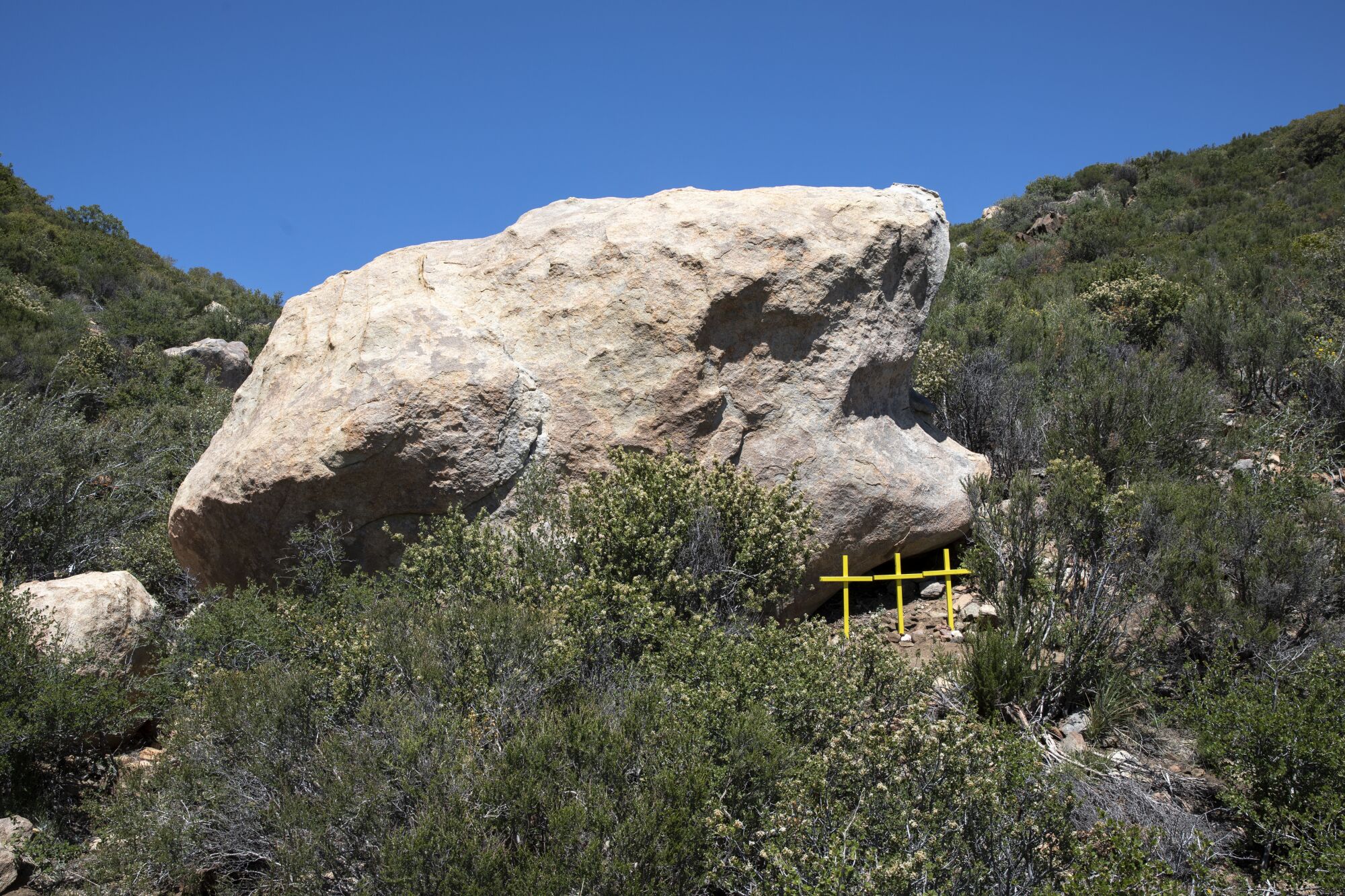
“It’s a beautiful thing that we’re here today, complete strangers, never met them, and we’re here to honor them,” Dulce Real told the other volunteers after the crosses were planted. Real said she is a first-generation U.S. citizen whose own family members had crossed the border under similar circumstances. Some crossed in the snow, while others watched members of their groups die.
“Every time we think of the desert, we think the desert is deadly, the desert is complicit of so many deaths,” Real said. “But it’s not the desert, it’s the border, it’s the policies that make the land deadly. The land isn’t complicit, it’s really just the people overseeing the land.”
For Nasada, the Franciscan priest, he hopes that “fellow Catholics and fellow Christians” can respect the life-saving work of border supply drops even if they disagree on immigration issues.“People will attack you, say ‘You’re just encouraging them,’” Nasada said. “I’m trying to save lives, whoever it is that needs this water.”Cordero, who leads groups on supply drops across San Diego and Imperial counties on most weekends of the year, plans to keep taking volunteers to the site where the crosses now stand. At least once or twice a year, the volunteers will replenish the supplies. On the next trip, he plans to outfit the crosses with small plaques engraved with the sisters’ names.
“They’re not just another number in the system,” Real told her fellow hikers on the mountainside as they gazed at the crosses, the wind whipping up from a canyon below. “And now we’re going to have a place where every time we come up here, we’re going to visit them.”
